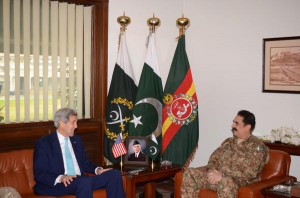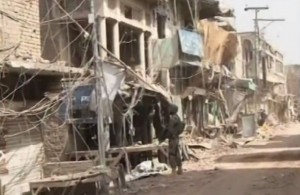Brennan’s Addiction to Signature Strikes Killed Weinstein
The US insists that the deaths of hostages Warren Weinstein and Giovanni Lo Porto were a “mistake”. Both the New York Times and Washington Post open their articles about the drone strike that killed them with descriptions couched in the language of error. The Times:
The first sign that something had gone terribly wrong was when officers from the C.I.A. saw that six bodies had been pulled from the rubble instead of four.
And in the Post:
After weeks of aerial surveillance, CIA analysts reached two conclusions about a compound to be targeted in a January drone strike: that it was used by al-Qaeda militants and that, in the moment before it was hit, it had exactly four occupants.
But as six bodies were removed from the rubble, the drone feeds that continued streaming back to CIA headquarters carried with them a new set of troubling questions, including who the two other victims were and how the agency’s pre-strike assessments could have been so flawed.
Consider that for a moment. Despite all the blathering from John Brennan about “near certainty” in his infamous drone rules (whose legal basis the government still steadfastly refuses to release), we are dealing yet again with deaths of innocents from a signature strike. In those strikes, the US kills without knowing precisely who the targets are. Instead, the US claims that the pattern of activities by those targeted match those of terrorists intent on striking out against the US. The more cynical among us note that there is hubbub over this strike merely because the innocents who were killed happen to be white instead of brown. But the outcome is the same: making the decision to kill based on incomplete evidence that doesn’t even include the actual identities of those in the crosshairs is bound to result in the collateral deaths of many who are not enemies of the US.
Recall that John Brennan made a power grab in the spring of 2012 to take charge of ordering signature strikes when JSOC told the White House that such strikes were not needed in Yemen. And, of course, Brennan immediately started using this tool as a political cudgel as well as the strategic weapon it was believed to represent. But let’s go for a moment to a part of Greg Miller’s Washington Post article linked above:
The deaths of the hostages follow other recent developments that have revealed divisions among the CIA and other agencies over whether to capture or kill a U.S. citizen.
Muhanad Mahmoud al Farekh was recently arraigned in a U.S. court on federal terrorism charges after he was captured by Pakistan and secretly flown to New York. His arrest raised questions about the frequency with which the U.S. government asserts that capturing terrorism suspects is not feasible. The CIA had been pushing to kill Farekh for more than a year before his arrest, current and former U.S. officials said.
Isn’t that interesting? It appears that Farekh was on CIA’s list of targets it would like to have killed in a targeted strike, with part of the justification for killing him being that it wouldn’t be feasible to capture him. And yet the Pakistanis did capture him. And that development points out an even bigger problem with the decision to hit the compound where Weinstein was killed: that compound is in the southern part of North Waziristan. Recall that Pakistan’s offensive to clear the tribal areas of terrorists began last June. See the map embedded in this post where I discussed the beginning of the offensive. Weinstein and Lo Porto were being held in the Shawal Valley, which is at the very southern end of North Waziristan. Miram Shah and Mir Ali, two of the hottest targets for US drone strikes sit in the central part.
Just a little more patience on the part of Brennan and his signature strike shop might have led to a very different outcome. In November, Pakistan’s military claimed that 90% of North Waziristan had been cleared of terrorists. And in the very same week of the strike that killed the hostages, Pakistan noted that the Shawal area was slated for clearing:
During a journalists briefing here, about the current visit of Chief of Army Staff General Raheel Sharif to Britain, he said operation Zarb-e-Azb was continuing successfully in North Waziristan and many areas including Mir Ali, Mirshah and Dattakhel were cleared of terrorists, many of whom were killed and arrested and their infrastructure was destroyed.
In these troubled areas, militants had set up infrastructure, training and call centres and they were making phone calls to people in other parts of the country for ransom, he added. Before start of the North Waziristan operation, Pakistan informed Afghanistan and International Security Assistance Force (ISAF), so that they could take action against terrorists who cross over the border.
Operations were continuing along the border areas with Afghanistan, with whom Pakistan had improved its relations and both countries were sharing intelligence, he added. He said in the next few months the remaining areas including Shawal would be cleared.
Although Pakistan’s military is not particularly noted for protecting citizens during these clearing actions in the tribal areas, it still stands out that Weinstein and Lo Porto were killed in Shawal on January 15 and Pakistan announced on the 18th that Shawal was next up for clearing. Would Pakistani forces have rescued the hostages? We will never know.
Even worse, Brennan was supposed to have stopped signature strikes in Pakistan. Returning to the Times article:
The strike was conducted despite Mr. Obama’s indication in a speech in 2013 that the C.I.A. would no longer conduct such signature strikes after 2014, when American “combat operations” in Afghanistan were scheduled to end. Several American officials said Thursday that the deadline had not been enforced.
Brennan will never give up his prized signature strikes. Greg Miller does note, though, that this strike was one of the last ones for “Roger”, who headed the counterterrorism center and was Brennan’s right hand man for signature strikes. But I’m pretty sure that we can count on Brennan to get Roger’s replacement up to speed on his prized tool very quickly.



